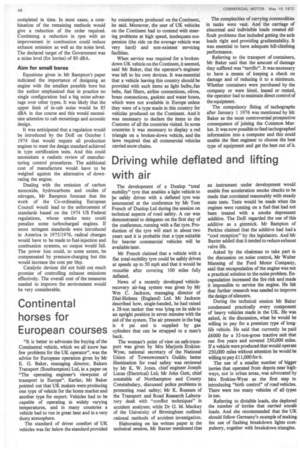Quest for quieter engines
Page 49

Page 50

If you've noticed an error in this article please click here to report it so we can fix it.
Outlining the Perkins viewpoint on "Legislation of noise and exhaust emission and the effect on commercial vehicle engines", Mr D. F. Bampton, technical legislation manager of Perkins Engines Ltd, said it would be difficult to reduce the noise level of some vehicles of just under 3.5 tons gvw to 82 dBA by October 11974. This could have a significant influence on marketing vehicles in this category, while, at the other end of the scale, manufacturers of 32ton-gross vehicles might well find it expedient to employ engines of at least 200 bhp to reduce the noise level to 86 dBA, rather than units with an output that was just sufficient to meet the 6 bhp/ton requirement.
To reduce noise at least cost, noise sources had to be identified. While the acoustic efficiency of exhaust and intake systems could be increased without a big drop in gas or air flow, there was scope for quieter cooling fans. This might mean a bigger radiator, which would create a major installation problem.
Engine noise could be cut by total encapsulation; the use of close-fitting engine shields; acoustic treatment of selected components; increasing attenuation by redesign of the structure; treatment of the engine compartment with the aid of acoustic barriers and acoustic absorption materials; and modulation of the combustion process.
Encapsulation (enclosing the engine) could reduce the level of a noisy engine by 10/15 dBA but was costly and created cooling and installation problems. Restructuring could provide a reduction of 5/10 dBA but would involve changes in manufacturing processes that could not be completed in time. In most cases, a combination of the remaining methods would give a reduction of the order required. Combining a reduction in rpm with an improvement in combustion could reduce exhaust emission as well as the noise level. The declared target of the Government was a noise level (for lorries) of 80 dBA.
Aim for small bores
Equations given in Mr Bampton's paper indicated the importance of designing an engine with the smallest possible bore but the author emphasized that in practice no single configuration had a big noise advan tage over other types. It was likely that the upper limit of in-cab noise would be 85 dBA in due course and this would necessitate attention to cab mountings and acoustic design.
It was anticipated that a regulation would be introduced by the DoE on October 1
1974 that would require all production engines to meet the design standard achieved in type certification tests. And this could necessitate a realistic review of manufacturing control procedures. The additional cost of manufacture would have to be weighed against the alternative of downrating the engine.
Dealing with the emission of carbon monoxide, hydrocarbons and oxides of nitrogen, Mr Bampton forecast that the work of the Co-ordinating European Council would lead to the enforcement of standards based on the 1974 US Federal regulations, whose smoke tests could penalize some turbocharged engines. If more stringent standards were introduced in America in 1975/1976, radical changes would have to be made to fuel-injection and combustion systems, so output would fall. The power loss could, to some extent, be compensated by pressure-charging but this would increase the cost per bhp.
Catalytic devices did not hold out much promise of controlling exhaust emissions effectively. The overall cost of the measures needed to improve the environment would be very considerable.




























































































































